Deep Focus: Detroit
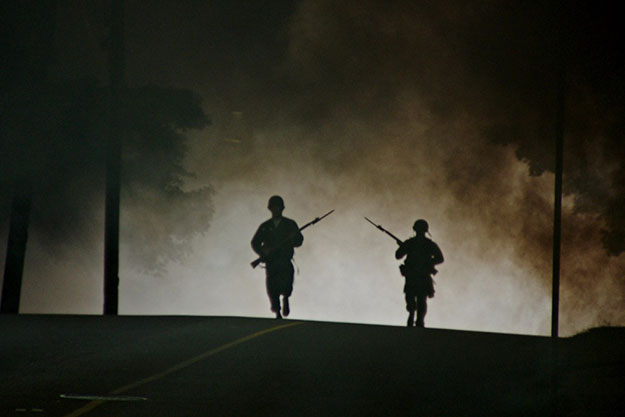
Detroit is angry, lucid, bludgeoning, subtle, and at times surprisingly moving. In their bravest collaboration so far, director Kathryn Bigelow and screenwriter Mark Boal (The Hurt Locker, Zero Dark Thirty) focus on the 12th Street Riot of 1967 that tore the Motor City apart along racial lines. They zero in on the atrocity that became known as the Algiers Motel Incident, in which a trio of white city policemen terrorized the patrons of the motel’s annex, a manor house set off from the main building.
Like the other major work on this event, John Hersey’s The Algiers Motel Incident (1968), the filmmakers see it as a flashpoint and a benchmark for race relations in this country. This obscenity included the brutal intimidation of two 18-year-old white women from Columbus, Ohio, who were staying at the Algiers. The cops’ poisonous reaction to their presence, filled with contempt, insecurity, and jealousy, led Hersey to declare that “sex” is “at the very core of racism” and just as crucial to consider as unequal justice, housing, and opportunity.
Bigelow and Boal boldly go there, too, while opening up their own bracing new angles on urban strife and racial unrest. This film’s core excitement comes from the thrill of discovery. Rarely do American moviemakers help us take hold of recent history and make sense of it. The revelations are as startling as the stop-and-go violence and the action’s hairpin turns. It wrenches the soul to see Cleveland Larry Reed (Algee Smith), the lead singer in a local R&B group, recoil from the racial hypocrisy that taints American pop culture after his nightmare stay at the Algiers. Melvin Dismukes (John Boyega), the black security guard who tries to help the innocents at the motel annex, becomes, in this re-telling, a sometimes heroic, ultimately tragic man in the middle.
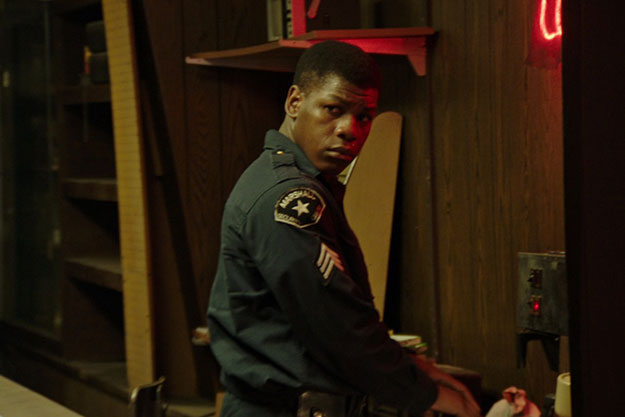
These actors provide the syncopated beat to this film’s big, wounded heart. Smith imbues Larry with an emotional transparency that textures his experience of torture and makes it excruciatingly real, while Boyega’s steady intensity and understated competence give us a moral baseline amid the carnage. Dismukes attempts to defuse volatile faceoffs only to have African-Americans insult him and whites use him as a patsy or a fall guy. Caught in a sure-fail situation, he’s like a Sidney Poitier character in extremis, in the period just before Poitier could slap a white man or proclaim, “They call me Mister Tibbs.” (In the Heat of the Night, where Poitier did both things, would premiere one week after the Detroit riot ended.)
The way Bigelow shapes their performances and those of the entire black ensemble, these actors don’t merely anchor the action—they magnetize it. As the director moves gutsily between group shots and one shots, panoramas and closeups, we feel we’re alternately on the inside with her characters, looking out, and the outside with the newsmen, looking in. Her style would be dizzying if she didn’t root the story in distinct human conflicts and emotion. No portrait of a city in flames brings you closer to the blaze.
Like many films that try to achieve an epic yet granular adventure, Detroit is imperfect—riveting, yes, but imperfect. There’s a basic imbalance in the material. Several sympathetic characters—Reed, Dismukes, and Juli Ann Hysell (one of the Ohio gals)—consulted on the script, along with seasoned Detroit journalist David Zeman, who led half a dozen researchers. They’ve ploughed some fresh ground, but not, unfortunately, when it comes to the racist cops. According to the closing legend, “The facts around the murders at the Algiers Motel on July 25th, 1967 were never conclusively established in a criminal proceeding. As a result, portions of this film were constructed and dramatized based on recollections of the participants and available documents.” That doesn’t explain everything. Presumably for legal reasons, the filmmakers turn the cops into composites. They lack the other characters’ authority and depth.
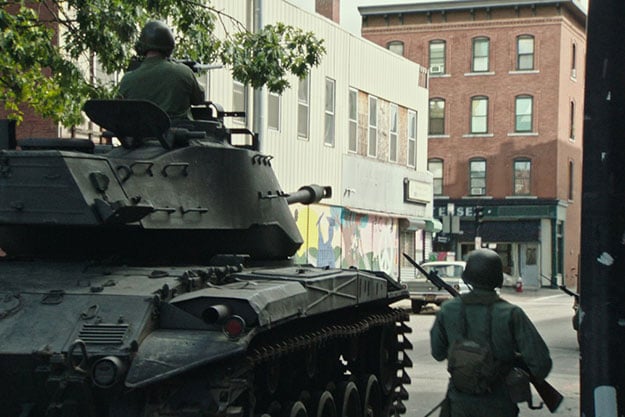
Will Poulter burns with malign urgency as the dominant bad cop, Krauss, but Bigelow and Boal’s group portrait of him and his partners is more circumstantial than psychological. Krauss offers one rationale for his fury: he says that if officers had shot looters and stone-throwers at the outset, they’d have quashed the riot. And he doesn’t hesitate to shoot a looter in the back after the turmoil has gone on for a day. In an affective, infuriating vignette, the wounded man succeeds in hopping a fence and sheltering beneath a car. He asks the elderly woman who notices him to summon his wife rather than call an ambulance or the police. Bigelow studs the film with eloquent real-life anecdotes like this one. They’re emblematic high points—but none centers on the men in blue.
The force is so overwhelmed that even the homicide detective who despises Krauss and says he’ll have him charged with murder tosses him back onto the streets. The cops feel exhausted and embattled long before they enter the Algiers. Earlier on July 25, a Detroit cop had been killed—the only police fatality during five days of rioting. When Krauss and his partners, Flynn (Ben O’Toole) and Demens (Jack Reynor), hear the report of a sniper shooting on the army National Guard from the motel annex, they enter an adrenalized zone that brings vengeful feelings and base instincts to the surface. The sound they hear that night comes from an Algiers tenant, Carl Cooper (Jason Mitchell), stupidly playing with a starter pistol. That’s enough to send Krauss rampaging into the Algiers, firing at anything that moves. He takes down Carl before he can flee the premises and plants a knife beside the corpse. Then he and his comrades roust everyone else in the manor house. They beat them with rifle butts on their bodies and heads. They turn a motel annex into the Heart of Darkness.
Whenever Bigelow and cinematographer Barry Ackroyd team up (as they did on Hurt Locker), the handheld camera becomes a diamond-tipped precision instrument. In Detroit it hits on telling details, like “Soul Brother” scrawled on store windows to protect black-owned shops, while providing the action with sweep and momentum as it whooshes down ruined streets. Along with editors William Goldenberg and Harry Yoon, these filmmakers make us feel as if we share the hair-trigger reflexes of soldiers and lawmen and the people facing their guns. Most of the movie wields a combination punch. When Guardsmen shoot out streetlights to cloak themselves in darkness, we understand how exposed and fragile their position is and immediately fear the consequences.
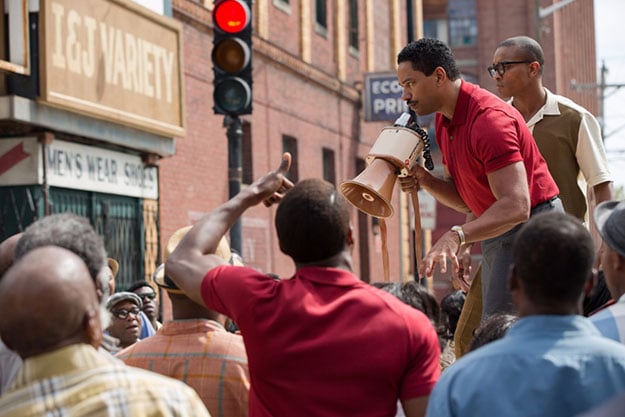
Because of its subject matter and veracious style, the movie may be pigeonholed as a “docudrama” and compared to true-crime stories with their primitive chronologies and jerky-cams. But Detroit is a fully formed, instinctive work of art that breaks open the boundaries of any genre. Bigelow and Boal pull off a five-act structure that would fit a Shakespeare history play.
Act I is exposition done right: Henry Louis Gates Jr.’s pithy history of African-Americans making their Great Migration, illustrated with the “dynamic cubist” art of Jacob Lawrence, whose muscular paintings about the black trek from the Deep South to the Industrial North conjure history on the march. It’s a marvelous opening stroke—a statement of the film’s ambitious social-political scope and marvelous aesthetic daring. In Act II, the action rises with volcanic speed and force as police shut down a “blind pig”—street parlance for an unlicensed private liquor club or stripped-down speakeasy. Here’s where the filmmakers put us on edge, viscerally and psychologically: they cue us to the complicated tensions roiling throughout the 143-minute running time. Two black cops enter first and break up a Vietnam vet’s homecoming party. Their presence rouses derision, not respect, just as, a bit later, a young black scorns Dismukes as an Uncle Tom. Unable to open a back door, the mostly white police move everyone out through the front, as a crowd gathers to watch spiffily dressed partygoers getting herded into paddy-wagons. Bigelow shows us how the people’s wrath soars when white cops press on the buttocks of black women as they push them inside the cage. We feel the onlookers merge into a mob—and we get exactly why they do. The instant vandalism breaks out is harrowing. We’re jazzed and repulsed to experience how cathartic it can be to smash a store window and pilfer a bicycle or a mattress. And Bigelow never lets us forget why. In a ubiquitous visual motif, the black-and-white TVs in every household advertise America as a lulling, materialistic dreamland.
Everything about this section is packed with suspense and nuance. By the time a young Congressman John Conyers Jr. (Laz Alonso) addresses a furious crowd, he knows the riot has evolved into protest and rebellion. He valiantly says change is coming and begs his constituents not to ruin their own neighborhoods, but he gets nowhere. In archival reports the filmmakers mesh seamlessly with fictional footage, police give up on mob control and focus on protecting firefighters, as federal troops and the National Guard move into Detroit like an occupying army.
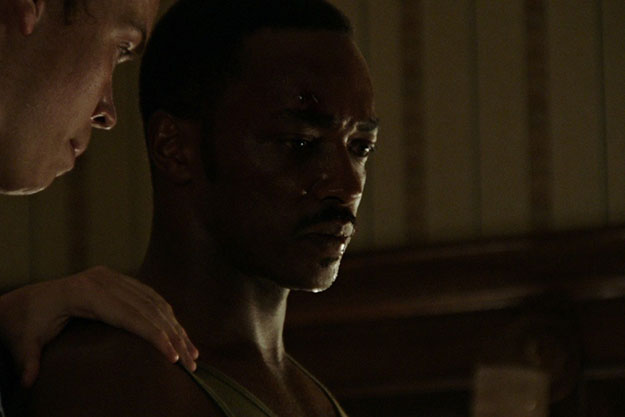
Meanwhile, in the wings of Detroit’s Fox Theatre, Larry’s R&B group, the Dramatics, prepare to follow Martha and the Vandellas, who bring an integrated audience to their feet with their signature Motown hits, “Nowhere to Run” and “Jimmy Mack.” Like so many of the fact-inspired subplots, this show seems too good and too sad to be true, but the filmmakers’ emotional commitment and confidence carry the day. Just before Larry and his group go on for their debut, the theater manager stops the music and clears the house, because the riot has come too close. Bigelow proves to be equally deft at staging random mayhem and patterned, formal set pieces, as the fans in the balcony split up and move in opposite directions for the exits. This director hits every possible grace note: she pauses for Larry to croon “If You Haven’t Got Love” to an empty theater. Larry and the Dramatics’ gofer, Fred Temple (Jacob Latimore), realize how dangerous Detroit’s streets have become only when rock-throwing crowds and looters on the run stymie the progress of their homeward-bound city bus. They hastily debark and take a room at the Algiers until (they think) the violence blows over.
The Algiers Motel Incident must be, as form dictates, the Act III climax. The stress is gut-clenching and nerve-wracking as Krauss and Flynn use fists and rifle-butts to batter the clientele, then spread-eagle everyone against a wall. Delivering unrelenting verbal and physical abuse with a paralyzing randomness, they begin to play the “Death Game” with Larry, Fred, and Carl’s best friends, as well as a sober-minded Vietnam vet, Robert Greene (Anthony Mackie), and the only two females, Juli (Hannah Murray) and Karen (Kaitlyn Dever). We’re inside the heads that Krauss wallops against the wall. We’re afraid for all their lives when he and Flynn demand to know where the sniper’s gun is and who shot at them. They yank a man who’s begging for his life into a vacant room and petrify him by firing off a shot. To his fellow prey, it sounds like an execution. Self-deluded, like all fanatics, the cops tell themselves it’s an “interrogation technique.” It proves a lethal tool for their unbridled hatred and sadism.
What hooks us before the cops arrive and keeps us watching when we want to look away are the multidimensional characters. Amidst the drama, Bigelow and Boal keenly analyze the social rift between Larry and Fred, two go-getters with big Motown dreams, and Carl and Lee (Peyton Alex Smith), funky idlers who mistrust anything mainstream. For Carl and Lee, anyone who thinks he’s getting somewhere is a fool. For Larry or Fred to say that John Coltrane died from heroin addiction (the jazz giant died eight days before) strikes Carl as an insult to a homegrown genius. Carl is a natural anarchist. When he fires the starter pistol, he acts out the aggression he feels whites direct toward him every single day. By contrast Mackie’s Greene, in a hard gem of a performance, boasts the self-contained temperament of a seasoned military man. He won’t undermine the cops’ authority, but he won’t play ball with them, either. The women are nonplussed when the cops express disgust that they’d fraternize or have sex with black men. To Juli and Karen, “it’s 1967”—modern times—and the men in blue are throwbacks as pitiful as they are scary. Both Murray and Dever work wonders with their limited roles, conveying disbelief and spunk and sisterly rapport. The women’s dread becomes palpable as the cops tear the dress off one of them and drag them both downstairs.
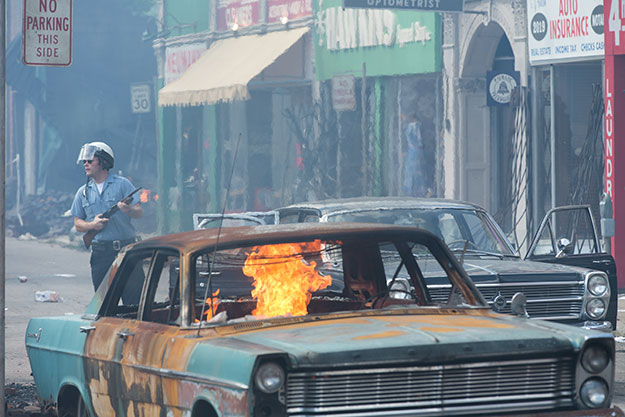
Few moments are more terrifying or weirdly transcendent than the instant the cops demand to hear these men and women pray for their lives. Every human detail, like the way the youthful, half-formed Auburey (Nathan Davis, Jr.), keeps tapping a nervous thumb against the wall, is agonizing and heartbreaking. There’s a terrible beauty to Larry’s trembling voice as he sings a gospel prayer—a shot of purity emerges from a well of debasement.
Does the motel episode go on too long? It may feel that way because there’s nothing fresh to discover in Krauss’s closed-up face, which we see a lot. He’s an implacable combination of determination, urgency, power-lust, and banality; his sharp, active eyebrows make it seem as if he’s practicing an Anglo-Saxon form of Kabuki. He’s striking and inscrutable—as much sociopath as racist. Nonetheless, Bigelow succeeds at creating a factual theater of cruelty out of jagged pacing, repeated acts, and harsh lighting that outlines every character equally. I doubt that she’d achieve the same sense of existential vertigo if she abbreviated it. This sequence lays out how dehumanization works without cutting the film’s own slender threads of humanity. We’re aghast when officers from several branches of law enforcement cede authority to Krauss, either by fleeing the scene or by participating in the games. Even belated acts of mercy register as welcome signs of life. Bigelow’s ability to sustain ambiguous human reactions within a story’s rugged contours keeps this movie vivid and alive.
Act IV, the falling action, lifts the spirit: it sustains and enriches the drama with a searing sort of tenderness. The scenes of family members and close friends learning and sharing the bad news depict African-American family life with warmth and sensitivity in the midst of viciousness and savagery. Gbenga Akinnagbe gives a towering performance as a blue-collar father who at first assumes he’s lost a different son, the one who, in a touching display of household nonsense talk, is “always googy-googy.” Boyega beautifully brings home Dismukes’ vulnerability in his innocent and unguarded reaction to the police investigating the crime.
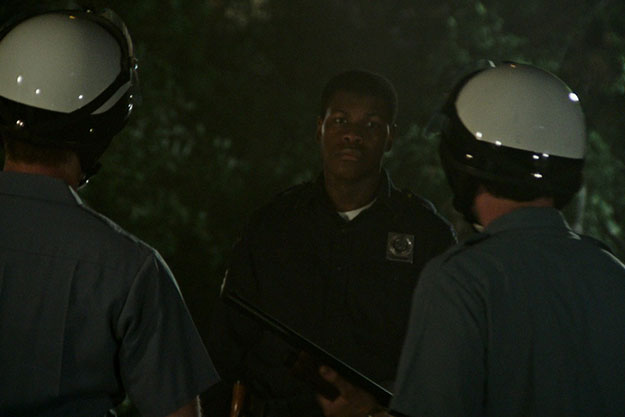
Act V, the denouement, is sketchy, as Bigelow rushes through the trials. The lack of resolution mirrors the maddening lack of clarity in the actual legal record. John Krasinski, though, brings an unexpected potency to the role of the cops’ dogged defense lawyer. And everything that touches on Larry’s struggle to heal himself as a choirmaster in a small black church is magical. We share in his hard-won grace as Larry sings James Cleveland’s gospel classic, “Peace Be Still.” By the time Bigelow fills us in on what happened to her main characters, we know, with a rush of feeling, that her film is emotionally and intellectually complete.
In the end, by homing in on the specifics of a horrific “incident,” Bigelow has crystallized the metropolitan chaos of Detroit and made it stand for any city blighted by inequality and racism. In the course of the movie, the city of Detroit comes to signify a warped state of mind and to embody, metaphorically, an ingrown, obdurate, layered kind of racism. As a setting for crime in the long hot summer of 1967, when racial uprisings broke out across the country, Detroit is like Robert Towne’s Chinatown in the long hot summer of 1937—a place where “You may think you know what you’re dealing with, but believe me, you don’t.”
Michael Sragow is a contributing editor to Film Comment and writes its Deep Focus column. He is a member of the National Society of Film Critics and the Los Angeles Film Critics Association. He also curates “The Moviegoer” at the Library of America website.







